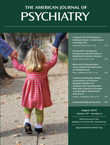Elevated Prevalence of Generalized Anxiety Disorder in Adults With 22q11.2 Deletion Syndrome
To the Editor: The 22q11.2 deletion syndrome (22q11.2DS) is a known genetic subtype of schizophrenia, with an often cited figure of 30% prevalence of major psychotic disorders (1). Several other neuropsychiatric phenotypes have also been reported in 22q11.2DS (1). Nonetheless, no studies, to our knowledge, have used completely nonpsychiatrically ascertained samples, thus leading to possible ascertainment bias in prevalence estimates.
To minimize psychiatric ascertainment bias, we studied the prevalence of psychiatric disorders in 40 adults with 22q11.2DS (18 men; median age: 30 years [range 20–57 years]) who were systematically ascertained at an adult congenital cardiac clinic and confirmed to have 22q11.2 deletions by standard methods (1). Patients were assessed by direct interview and comprehensive collateral information (including medical records, many originating before the diagnosis of 22q11.2DS) for lifetime axis I DSM-IV psychiatric diagnoses using the Structured Clinical Interview for DSM-IV Axis I Disorders as previously described (1). Prevalence of each disorder was calculated and compared with general population estimates from major studies (2, 3) using Fisher's exact test or Yates' chi-square test, after excluding five subjects with moderate/severe mental retardation. Two-tailed p values <0.05 were considered significant.
Nine subjects (22.5%) had schizophrenia or schizoaffective disorder (median age at onset: 22 years), which is a significantly elevated prevalence relative to the general population (1.2%; p<0.0001) (3). Five (12.5%) had generalized anxiety disorder, also elevated relative to the general population estimate (5.7%; p=0.047) (2). Prevalence values for lifetime major depression (17.5%), obsessive-compulsive disorder (5.0%), social phobia (5.0%), attention deficit hyperactive disorder (7.5%), and substance use disorders (12.5%) were not significantly different from population estimates. Twenty-four subjects (60%) had at least one disorder, and the majority of these (N=16 [40%]; median age: 30 years) had nonpsychotic disorders only.
This is the largest adult 22q11.2DS sample ascertained from a single nonpsychiatric source reported to date. Our novel findings include a significantly elevated prevalence of generalized anxiety disorder in adults with 22q11.2DS compared with the general population. Among adults with no to mild mental retardation, about twice as many may be expected to have treatable nonpsychotic disorders as psychotic disorders. Prevalence of major psychotic disorders may be lower than some previous estimates using heterogeneous samples. Accurate estimates of the prevalence of psychiatric illnesses in adults with 22q11.2DS are essential for management and genetic counseling. The present results also have implications for variable expression in human and animal models of 22q11.2 deletions and the need for raised awareness of 22q11DS for clinicians in mood and anxiety clinics. This study demonstrates the utility of nonpsychiatrically ascertained samples for elucidating the significant psychiatric disorders in genetic syndromes, which is of particular relevance given emerging reports of other copy number variations in psychiatric samples.
1 : The schizophrenia phenotype in 22q11 deletion syndrome. Am J Psychiatry 2003; 160:1580–1586 Link, Google Scholar
2 : Lifetime prevalence and age-of-onset distributions of DSM-IV disorders in the National Comorbidity Survey Replication. Arch Gen Psychiatry 2005; 62:593–602 Crossref, Medline, Google Scholar
3 : Lifetime prevalence of psychotic and bipolar I disorders in a general population. Arch Gen Psychiatry 2007; 64:19–28 Crossref, Medline, Google Scholar



